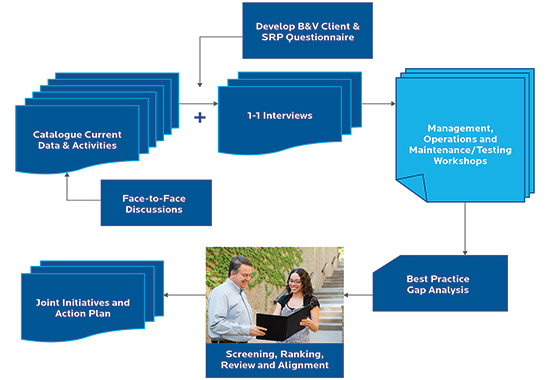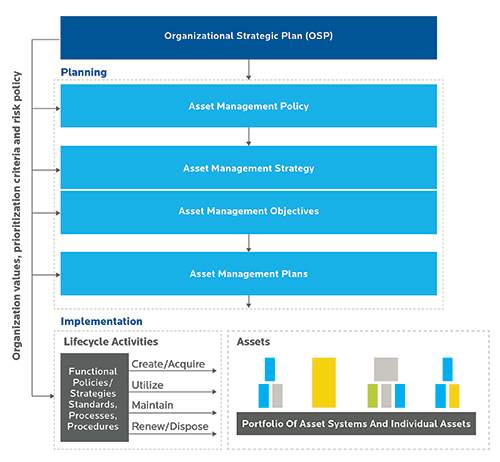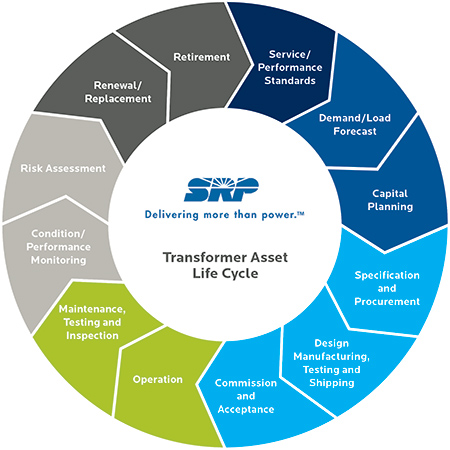The current financial climate presents utility managers with a key challenge: the delivery of levels of service to customers at the most efficient balance of cost and risk. Increasingly, utilities are adopting asset management approaches in an effort to improve performance, enhance reliability, meet regulatory requirements, optimize capital investment, and reduce operational costs.
Utilities readily adopt tactical asset management approaches, which focus on understanding asset condition and performance and improving asset maintenance. However, more strategic approaches to asset management decision making are less commonly adopted. These strategic approaches involve the implementation of an integrated, information driven, decision making framework that links the tactical decisions in a measurable way to the strategic goals of the organization.
Salt River Project (SRP) in Arizona developed and is implementing a strategic, good practice asset management framework for the management of critical power trans-former assets.
SRP’s Critical Power Transformer Fleet
SRP owns and operates about 500 transformers with a high side voltage of at least 69 kV. Of these transformers, 15 per cent have voltages at or above 230 kV and are referred to as Extra High Voltage (EHV). Numerous failures in the EHV transformers have been recorded in recent years, mostly independent of age.
SRP recognizes the criticality of these assets and has adopted a proactive approach to understanding and mitigating their risk of failure. SRP’s transformer management program consists of time based maintenance scheduling, monitoring and condition inspection and testing, quality audits and inspections, spares management, emergency standby mobile transformers, and an ongoing replacement program.
Drivers for Asset Management Implementation
In 2011, a critical power transformer unexpectedly failed at one of SRP’s vital receiving stations. The transformer was not salvageable so an available spare was installed in 30 days. The component root cause analysis determined there was a bushing failure however the details of the true root cause have not been finalized. Further analysis of SRP’s historical performance data showed that a significant proportion of SRP’s critical power transformer failures, particularly at high voltage levels, are due to bushing failures.
One of the results of this sequence of events was for SRP to commission an outside consultant (Black & Veatch) to review the way SRP manages its 230 kV and 500 kV transformer fleet. The review was to consider the complete asset lifecycle, examining how SRP engineers, specifies, designs, procures, installs, commissions, maintains, tests, and manages these critical assets.
SRP and Black & Veatch decided to undertake the review using Publically Available Specification 55 (PAS 55) which provides a framework for assessing and optimizing asset management maturity. Now internationally recognized, PAS 55 provides an essential, objective definition of what is required to demonstrate competence, establish improvement priorities and make better, clearer connections between strategic organizational plans and the actual day-to-day work and asset realities.
Assessing Asset Management Maturity
Effective asset management is all about achieving the appropriate balance between cost, risk and performance. Black & Veatch’s focus was to provide results that could be used to manage SRP transformer related risks now, as well as providing a roadmap for asset management process improvement in the future. Figure 1 summarizes the overall project approach.

Figure 1: Approach to Transformer Asset Management Maturity Assessment
The review included assessment of:
- Current SRP organizational structure and responsibilities for transmission/distribution operations, maintenance and testing
- Historical transformer and transformer component failure data for transformer failures with high side voltage greater than 69 kV and larger than 20 MVA
- Operation and maintenance history for 69/115/230/500 kV transformers
- SRP standard transformer specifications
- Industry analyses of failure data and survival curves for transformers and related equipment
- Industry practices and procedures documentation
- Current SRP policies and procedures related to operations and maintenance of transformers, including:
- Technical procedures associated with procurement of new transformers
- Design review process
- Supplier qualification process
- Supplier surveillance procedures
- Supplier approval process
- Supplier quality control audit procedures
- Factory and field test procedures for transformers
- Technical procedures associated with procurement of new transformers
The results of this assessment was an agreed set of issues, activities, and areas of focus which was used to ensure the work in subsequent stages was well targeted and cost effective.
The asset management maturity assessment commenced with a series of structured interviews and workshops aimed at gaining a complete 360 degree view of those areas of focus relating to SRP’s design, procurement, engineering, operations, maintenance and testing procedures and processes.
Historical Failure Data: Industry Survey and Other Sources
The initial stages of the project entailed the collation and analysis of existing historical data in order to ascertain what the key issues are, what the current quality of data and information is and start to mine this data to identify common causes of failure and components of risk. Analysis of historic data was a very important aspect of this project as it was used to establish failure trends and patterns that informed subsequent phases of the work and identified ‘quick win’ process improvements.
Industry Survey. In order for any statistical analysis of historical failure data to be meaningful, sufficient failure data must be analyzed. Due to the relatively small stock of critical power transformers owned by SRP, the failure dataset was relatively small. To supplement the SRP data, some 12 organizations were approached and agreed to participate in an industry survey to share experiences and failure data. These organizations were asked whether transformer failures are an issue for them and whether they have relevant failure data that they are prepared to share. Organizations who contributed their data to the pooled dataset were given access to the complete set of assembled data in return.
Other Information Sources. In order to maximize the use of all available failure data, a range of research, published papers, industry associations and manufacturers data were also analyzed including institutional sources (EEI, IEEE, CIGRE, etc.), private sources (Hartford SB, IAEI, etc.), and EPRI (with aid from SRP). These data were used to supplement SRP and industry survey data to ensure the analysis was unbiased by the sample composition and that every opportunity to access relevant data had been taken.
About PAS 55
Developed by the Institute of Asset Management (IAM) in the United Kingdom, the latest version PAS 55:2008 is published by the British Standards Institute and is used by utilities and asset-centric organizations worldwide. The PAS 55 specification defines good practice asset management and provides guidance for its implementation in asset intensive industries. It is currently being developed into ISO standard 55000 with some 22 countries (including the United States) engaging in the process.
PAS 55 provides a management framework that enables an organization’s strategic vision and goals to be achieved through the development and application of asset centric strategies and plans (see Figure 2, adapted from PAS 55:2008). This integrated approach establishes a single ‘line of sight’ from the organization’s leadership team down to the asset operators and maintainers, so everyone has a clear understanding of what they are required to do in order to achieve the organization’s strategic goals.

Figure 2: PAS 55 Asset Management Framework (adapted from PAS 55:2008)
(click to enlarge)
This framework enables the leadership team to implement an asset management policy that defines the approach to asset management within the organization and that can be communicated within the organization and to external stakeholders, in the same way that health and safety, or environmental policies are.
Strategies and specific, measurable, objectives can then be developed to focus on the management of the asset lifecycle for different asset groups (asset lifecycle strategies) and the development of process and procedural improvements (functional strategies). Asset management plans (such as network development plans, capital investment plans, asset maintenance plans) are then developed in accordance with the strategies.
The PAS 55 specification contains a 28-point checklist of good asset management practices. Detailed guidance is provided along with examples of good practice in each of these areas. The focus is on an integrated approach to asset management that is systematic, risk based, and optimizes the asset lifecycle for performance, cost and risk.
PAS 55 is used by many organizations worldwide. National Grid was one company to lead the way in development and implementation of PAS 55. It is used by a number of utilities in the United Kingdom including all the electricity and gas network utilities, and a growing number in Europe, the Middle East, Asia and the Americas. Energy industry examples include TRANSCO in Abu Dhabi, CLP Power in Hong Kong, BC Hydro and Hydro One in Canada.
There are a number of benefits that these organizations are gaining from using PAS 55, including being able to demonstrate competent sustainable asset stewardship to stakeholders, who can include regulators, investors and customers. Improved processes, clearly defined strategies and targets and following a risk based approach will lead to improved decision making and achieving the optimal balance between cost, risk, and performance. The benefits of PAS 55 for leadership teams include the implementation of an asset management policy throughout the business to ensure alignment of activities with the strategic goals of the organization, provision of a framework for a long term asset management capability improvement plan, the ability to track and report on improvements in the organization’s asset management capability and clear sight and the ability to review the organization’s asset management approach to ensure its suitability and effectiveness.
Application of PAS 55 to SRP
Using the PAS 55 maturity assessment approach, a total of 33 interviews were held with a range of SRP staff whose responsibilities cover the whole of the transformer asset lifecycle, along with corresponding processes and documentation. Each of the 28 practices in the PAS 55 checklist were addressed and scored and a gap analysis undertaken to identify areas of deficiency compared to defined good practice. In addition to the interviews, three workshops were held with operations, maintenance and management staff to discuss the initial analysis and clarify initial conclusions. From this gap analysis an improvement plan was then developed, designed to close the identified gaps.
A key output of the gap analysis was the development of an asset centric (rather than an organization centric) view of transformer management. This view was applied to target the recommendations at each phase of the transformer asset lifecycle, as illustrated in Figure 3.

Figure 3: SRP Transformer Asset Lifecycle
(click to enlarge)
For each of the asset lifecycle phases, a guide to good practice was developed to assist in the assessment of the current ‘maturity’ or effectiveness of SRP’s current approach to transformer asset management as well as to provide a summary reference document for SRP’s future use. These good practices were developed based on Black & Veatch subject matter experts’ industry knowledge and experience, PAS 55 guidance for asset management good practice, and Asset Management – an anatomy published by the Institute of Asset Management.
Findings and Initiatives
The overall score for SRP’s transformer asset management maturity put SRP in the asset management ‘development’ stage, as defined by PASS 55. The maturity assessment has highlighted areas for improvement and the gaps that need to be closed.
Formation of a dedicated transformer asset management team is recommended, along with development of a transformer asset management policy, strategy and objectives. Black & Veatch and SRP also developed a number of asset management initiatives (listed below) and a roadmap for their implementation:
- Transformer criticality assessment
- Risk management process development
- Condition based maintenance strategy
- Updated maintenance processes and procedures
- Prioritized bushing replacement program
- Creation of a transformer asset management system ‘Toolkit’
- Transformer spare and replacement process
- Escalated installation of substation Intelligent Electronic Devices (IEDs)
- Additional transformer analysis
Recommendations for short and long term improvements were prioritized using a cost-benefit analysis (CBA) approach so that the tangible business benefits of each investment were clearly understood.
Implementation
SRP plans to implement the identified initiatives over a period of three to four years to fully embed asset management good practice across the lifecycle of transformer assets.
The challenge of improving asset management practices should not be underestimated. Concerted effort is required to change organizational culture, paradigms, practices, and in some cases, the structure of the organization.
Leadership and communication are fundamental to this effort, and the initiative must have full buy-in at the highest levels to be successful. However, the successful implementation of an improvement plan is not the end of the journey. A key element of PAS 55 is continual improvement, so further refinements and improvements should be considered where it is cost effective. Effective leadership at all levels in the organization will be required to sustain and improve asset management good practices.
About the Authors
 Will Williams is Director of Asset Management at Black & Veatch. His asset management expertise includes asset failure analysis, risk assessment, maintenance optimization, business planning, operational efficiency, and infrastructure rehabilitation. He was previously at Halcrow as Vice President and Global Director of Asset Management for Water and Power. Reach him at WilliamsWD@BV.com.
Will Williams is Director of Asset Management at Black & Veatch. His asset management expertise includes asset failure analysis, risk assessment, maintenance optimization, business planning, operational efficiency, and infrastructure rehabilitation. He was previously at Halcrow as Vice President and Global Director of Asset Management for Water and Power. Reach him at WilliamsWD@BV.com.
 Martin Jones is a Principal Consultant at Black & Veatch, and a civil engineer specializing in utility asset management, regulatory audit, and wastewater engineering. He has conducted asset maturity assessments, asset valuations, and PAS 55 strategy development and implementation for utilities in North and South America, the UK, and around the world. Contact Martin at JonesM2@BV.com.
Martin Jones is a Principal Consultant at Black & Veatch, and a civil engineer specializing in utility asset management, regulatory audit, and wastewater engineering. He has conducted asset maturity assessments, asset valuations, and PAS 55 strategy development and implementation for utilities in North and South America, the UK, and around the world. Contact Martin at JonesM2@BV.com.
 Scott Anderson is the Manager of Apparatus Engineering at SRP responsible for the specification, procurement, award, commissioning and acceptance of all substation equipment.The department also oversees substation supplier quality and is in the process of developing an asset management program. Prior to joining SRP in 2002, Scott worked for Motorola where he was responsible for electrical and control systems at semiconductor manufacturing facilities. Reach him at scott.anderson@srpnet.com
Scott Anderson is the Manager of Apparatus Engineering at SRP responsible for the specification, procurement, award, commissioning and acceptance of all substation equipment.The department also oversees substation supplier quality and is in the process of developing an asset management program. Prior to joining SRP in 2002, Scott worked for Motorola where he was responsible for electrical and control systems at semiconductor manufacturing facilities. Reach him at scott.anderson@srpnet.com







